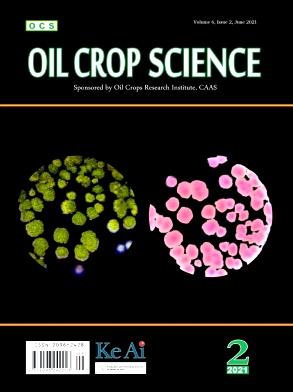中国五个主要产区亚麻籽的营养品质评价
Q3 Agricultural and Biological Sciences
引用次数: 0
摘要
亚麻(Linum usitatissimum L.)是中国高海拔干旱地区重要的油料作物。亚麻籽富含多种营养成分。然而,不同产地亚麻籽的营养品质仍不清楚。本研究对中国5个亚麻籽产地的亚麻籽营养特性进行了研究。对亚麻籽的25项营养品质指标进行了分析。随后,采用聚类分析、主成分分析(PCA)和偏最小二乘判别分析(PLS-DA)等化学计量学方法对亚麻籽营养品质特征进行了分析。结果表明,不同产地亚麻籽的营养品质存在显著差异。γ-生育酚、维生素E、植物甾醇、油酸、α-亚麻酸、环蒿烯醇6项品质指标对产地敏感。其中,宁夏亚麻籽、内蒙古亚麻籽和河北亚麻籽的优势特征营养成分分别为维生素E (17.3 mg/100g)、α-亚麻酸(52.6%)、环蒿烯醇(1738.1 mg/kg)和植物甾醇(3032.0 mg/kg)。本研究促进了当地亚麻籽产业的高价值开发利用。本文章由计算机程序翻译,如有差异,请以英文原文为准。

Evaluation of the nutritional qualities of flaxseeds from five main producing areas in China
Flax (Linum usitatissimum L.) is an important oil crop in the high-altitude arid regions of China. Flaxseed is rich in various nutrients. However, the nutritional qualities of flaxseeds from different producing areas are still unclear. In this study, the nutritional characteristics of flaxseed from five producing areas in China were investigated. Twenty five nutritional quality indices in flaxseed were analyzed. Subsequently, chemometric methods, including cluster analysis, principal component analysis (PCA) and partial least square discriminant analysis (PLS-DA), were employed to discover the characteristics of nutritional qualities in flaxseeds. The results revealed there are significant differences in nutritional qualities among flaxseeds from different production areas. Six quality indices including γ-tocopherol, vitamin E, phytosterols, oleic acid, α-linolenic acid, and cycloartenol were susceptible to producing area. In detail, the superiorcharacteristic nutrients of Ningxia flaxseed, Inner Mongolia flaxseed and Hebei flaxseed are vitamin E (17.3 mg/100g), α-linolenic acid (52.6%) and cycloartenol (1738.1 mg/kg), and phytosterols (3032.0 mg/kg), respectively. This study promotes the high-value development and utilization of local flaxseed industry.
求助全文
通过发布文献求助,成功后即可免费获取论文全文。
去求助
来源期刊

Oil Crop Science
Food Science, Plant Science, Agronomy and Crop Science
CiteScore
3.40
自引率
0.00%
发文量
20
审稿时长
74 days
 求助内容:
求助内容: 应助结果提醒方式:
应助结果提醒方式:


